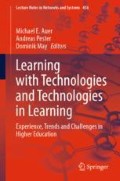Abstract
The motivation of the students is an essential component in their good performance and in the assimilation of the contents of the various disciplines they receive during their career. Teachers, in order to awaken the interest of students and as part of their methodological work, constantly seek new didactic resources that enrich the teaching–learning experience. Augmented Reality, as a didactic resource, has contributed to awakening true interest among students. This statement has been corroborated by different international studies that show high levels of satisfaction when students use this technology, in addition to the significant increase in levels of motivation when students are immersed in training activities with it. Along with motivation, it has been shown that the use of Augmented Reality enhances more motivating, collaborative and interactive training scenarios and helps a more open and creative education. Therefore, the objective of this research was to increase the motivation of the students, as well as the training of competences in the Computer Architecture course of the Computer Engineering career through a teaching aid that made use of Augmented Reality. This tool was applied to the second year of the aforementioned degree and after a comparative study of the results obtained by the students during 3 academic years, including the current one, increases in motivation and appropriation of competences were evidenced, expressed in the evaluations of performance obtained.
Access this chapter
Tax calculation will be finalised at checkout
Purchases are for personal use only
References
Azuma RT (1997) A survey of augmented reality. Presence Teleoperators Virtual Environ 6(4):355–385. https://doi.org/10.1162/pres.1997.6.4.355
Sato K, Sakamoto N, Shimada H (2015) Visualization and management platform with augmented reality for wireless sensor networks. Wirel Sens Netw 07(01):1–11. https://doi.org/10.4236/wsn.2015.71001
Johnson L, Adams Becker S, Cummins M, Estrada V, Freeman A, Hall C. NMC Informe Horizon (2016) Edición Superior de Educación (2016)
Chang H-Y, Wu H-K, Hsu Y-S (2013) Integrating a mobile augmented reality activity to contextualize student learning of a socioscientific issue. Br J Educ Technol 44(3):E95–E99. https://doi.org/10.1111/j.1467-8535.2012.01379.x
Cuendet S, Bonnard Q, Do-Lenh S, Dillenbourg P (2013) Designing augmented reality for the classroom. Comput Educ 68:557–569. https://doi.org/10.1016/j.compedu.2013.02.015
Barroso Osuna JM, Gallego Pérez ÓM (2016) Producción de recursos de aprendizaje apoyados en Realidad Aumentada por parte de estudiantes de magisterio. EDMETIC 6(1):23 (2016). https://doi.org/10.21071/edmetic.v6i1.5806
Pérez Díaz R (2016) Realidad aumentada. Tecnología para la formación. Edutec Rev Electrónica Tecnol Educ 57:141 (2016). https://doi.org/10.21556/edutec.2016.57.768
Cabero-Almenara J, Roig-Vila R (2019) The motivation of technological scenarios in augmented reality (AR): results of different experiments. Appl Sci 9(14):2907. https://doi.org/10.3390/app9142907
Thomas R, Linder K, Harper N, Blyth W, Yee V, Bahula T (2019) Current and future uses of augmented reality in higher education. IDEA
Holland JL, Lee S, Daouk M, Agbaji DA (2020) Higher education teaching and learning with augmented reality. In: Alqurashi E (ed) Handbook of research on fostering student engagement with instructional technology in higher education. IGI Global (2020), pp 229–248
Sáez-López JM, Cózar-Gutiérrez R, González-Calero JA, Gómez Carrasco CJ (2020) Augmented reality in higher education: an evaluation program in initial teacher training. Educ Sci 10(2):26. https://doi.org/10.3390/educsci10020026
Ivana Stojšić A, Ivkov-Džigurski O, Maričić J, Stanisavljević J, Milanković Jovanov TV (2020) Students’ attitudes toward the application of mobile augmented reality in higher education. Društvena istraživanja - Časopis za opća društvena pitanja 29(4):535–554. https://www.ceeol.com/search/article-detail?id=927998
Merino C, Pino S, Meyer E, Garrido JM, Gallardo F (2015) Realidad aumentada para el diseño de secuencias de enseñanza-aprendizaje en química. Educ Química 26(2):94–99. https://doi.org/10.1016/j.eq.2015.04.004
Álvarez de Zayas C (2004) Didáctica General La Escuela en la Vida, 6ta ed. Cochabamba: Kipus
Gutiérrez Moreno RB (2001) El contenido del Proceso Pedagógico. Su enfoque complejo integral. IPS Félix Varela, Santa Clara, Cuba
Redondo Domínguez E, Sánchez Riera A, Moya Sala J (2012) La ciudad como aula digital: enseñando urbanismo y arquitectura mediante Mobile Learning y la realidad aumentada: un estudio de viabilidad y de caso. ACE Archit City Environ https://doi.org/10.5821/ace.v7i19.2560
Kowarski I (2019) What can you do with a political science degree? Best Graduate Schools, US News, U.S. News - Education, May 02, 2019. https://www.usnews.com/education/best-graduate-schools/articles/2019-05-02/what-can-you-do-with-a-computer-science-degree (Accessed 23-8-2021)
Estrada JL (2017) Ingeniería Informática - Juventud Rebelde - Diario de la juventud cubana. Juventud Rebelde, La Habana
Cardona-Moltó M-C (2002) Introducción a los métodos de investigación en educación
Taylor SJ, Bogdan R, Piatigorsky J (1994) Introducción a los métodos cualitativos de investigación: la búsqueda de significados. Paidós
Fabila A, Minami H, Izquierdo J (2013) La escala de Likert en la evaluación docente: acercamiento a sus características y principios metodológicos. Perspect Docentes 52
Lin T-J, Duh HB-L, Li N, Wang H-Y, Tsai C-C (2013) An investigation of learners’ collaborative knowledge construction performances and behavior patterns in an augmented reality simulation system. Comput Educ 68:314–321. https://doi.org/10.1016/j.compedu.2013.05.011
Cózar Gutiérrez R, del Valle de Moya Martínez JA, Hernández Bravo JR, Bravo H (2015) Tecnologías emergentes para la enseñanza de las Ciencias Sociales. Una experiencia con el uso de Realidad Aumentada en la formación inicial de maestros. Digit Educ Rev 27 (2015). http://greav.ub.edu/der
Trapero H et al. (2020) Using augmented reality (AR) in innovating pedagogy: students and psychologists’ perspectives
Author information
Authors and Affiliations
Corresponding author
Editor information
Editors and Affiliations
Rights and permissions
Copyright information
© 2022 The Author(s), under exclusive license to Springer Nature Switzerland AG
About this chapter
Cite this chapter
Barrientos Núñez, I., Dorta Pina, D. (2022). Augmented Reality as a Teaching Resource in Higher Education. In: Auer, M.E., Pester, A., May, D. (eds) Learning with Technologies and Technologies in Learning. Lecture Notes in Networks and Systems, vol 456. Springer, Cham. https://doi.org/10.1007/978-3-031-04286-7_11
Download citation
DOI: https://doi.org/10.1007/978-3-031-04286-7_11
Published:
Publisher Name: Springer, Cham
Print ISBN: 978-3-031-04285-0
Online ISBN: 978-3-031-04286-7
eBook Packages: Intelligent Technologies and RoboticsIntelligent Technologies and Robotics (R0)

